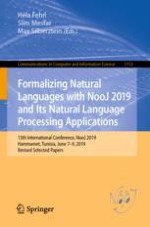2020 | OriginalPaper | Buchkapitel
Arabic Learning Application to Enhance the Educational Process in Moroccan Mid-High Stage Using NooJ Platform
verfasst von : Ilham Blanchete, Mohammed Mourchid, Samir Mbarki, Abdelaziz Mouloudi
Erschienen in: Formalizing Natural Languages with NooJ 2019 and Its Natural Language Processing Applications
Aktivieren Sie unsere intelligente Suche, um passende Fachinhalte oder Patente zu finden.
Wählen Sie Textabschnitte aus um mit Künstlicher Intelligenz passenden Patente zu finden. powered by
Markieren Sie Textabschnitte, um KI-gestützt weitere passende Inhalte zu finden. powered by
